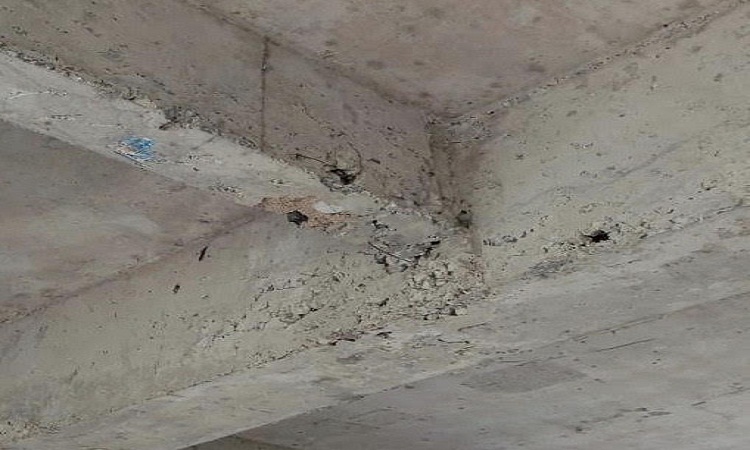Honeycombs are hollow spaces and cavities are left in concrete mass on the surface or inside the mass where concrete could not reach. These look like honey bees nest. Improper vibration and workability of concrete are the main causes of honeycombs in concrete.
Honeycombs that are on sides are visible to naked eyes and it can be detected easily as soon shuttering is removed. Honeycombs that are inside the mass of concrete can only be detected by advanced techniques like ultrasonic testing etc.

Honeycombs can be corrected by increasing the sand and cement content of the mix and by proper mixing, placing, and compaction. Alternatively, honeycombing may be caused by leakage of mortar fraction or grout from the concrete at construction or formwork joints. The obvious solution here is to ensure that joints are leak-free and well-sealed.
Small and shallow areas of honeycombing are probably mainly cosmetic. However, deeper areas will lead to a local reduction in the protection to the reinforcement from the concrete cover & hence possibly durability problems in the future.

Causes of Honeycombs in Concrete
Honeycombs are due to non-reaching of concrete to all places due to which cavities and hollow pockets are created, the main reasons are;
- Improper compaction to concrete.
- Less cover to reinforcement bars.
- Inappropriate workability in concrete.
- Concrete already set before placing.
- High concrete free fall while pouring.
- Formwork not watertight/rigid.
- More coarse aggregates than designed mix proportions and oversized aggregates.
- Improper placement of bars at beam and column junction.
- Addition of more water than concrete mix designed at the site for achieving workability.
- Highly congested reinforcement.

- Improper detailing and/or fixing of steel.
- Places like the junction of the beam to beam to column and to one or more beams are typical spots where honeycombs are observed. This is due to the jumbling of reinforcement of beams and column rods at one place; special attention is required at such place during concreting and vibrating.
- The presence of more percentage of the bigger size of aggregate in concrete also prevents concrete to fill narrow spaces between the reinforcement rods.

Remedies for Honeycombs in Concrete
- Use a mix with appropriate workability for the situation in which it is to be placed.
- Ensure the concrete mix has sufficient fines to fill the voids between the coarse aggregate.
- Concrete fall should be kept minimum.
- Ensuring the concrete is fully compacted and placing methods minimize the risk of segregation.
- Ensure that the formwork is rigid, the joints are watertight and penetrations through the formwork are properly sealed.
- At places of the junction of columns and beams, concrete with strictly 20nn and down aggregates should be used with slightly more water and cement to avoid honeycombs.
- Tapping with a wooded hammer the sides of shuttering from outside during concreting and vibrating will help to minimize honeycombs to a great extent in the case of beams and columns.
- The use of a thinner needle says 25mm or less with a vibrator at intricate places of concreting will also help in reducing honeycombs to a great extent.
- Strictly speaking, wherever honeycombs are observed in concrete, the affected area should be broken and the portion should be re-concreted after applying grouting chemicals to the old surface.
- Honeycombs as detected not only reduce the load-bearing capacity but water finds an easy way to reinforce rods and rusting and corrosion starts.
- Corrosion is a process that continues through reinforcement rods even in good concrete, this results in losing grip between rods and concrete which is very dangerous to the safety and life of concrete structures.
- Reinforced concrete structures have failed within 20 to 30 years of their construction due to honeycombs which is less than half their projected life. Especially no risk should be taken in the case of columns, machine foundations, raft, beams, etc. where breaking & recasting is the only best way.
- In the case of honeycombs on the surface pressure grouting with a cement-based chemical which are non-shrinkable can be adopted after taking the opinion of the designer and acting as per his advice.
- It will not be out of context to point out that contractors and their supervisors are in the habit of hiding honeycombs by applying super facially cement plaster on the honeycombs, hence site engineers must be very cautious.

